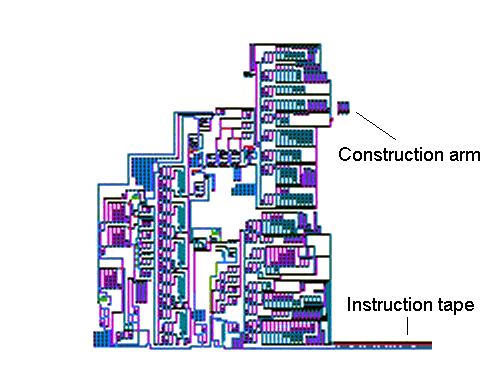Self-Replicating Machines
Will Stevens
Introduction 2 of 5
History
In the late 1940s the mathematician John von Neumann began to explore the possibility of making a self-replicating machine. He proposed a machine something like the robot in the room full of parts described on the previous page. Building such a machine with the technology available at the time would have been very difficult, so von Neumann set himself the simpler task of investigating the logical structure of self-replicating machines. To do this, he invented an imaginary two-dimensional universe (known as a cellular automaton) without the mechanics and physical laws that our universe has. In this imaginary universe, von Neumann was able to design a self-replicating pattern. His design was completed by Arthur Burks and published in 1966. In 1995 Pesavento and Nobili simulated part of von Neumann's design. The diagram below shows von Neumann's SRM.

John von Neumann's self-replicating machine. The instruction tape and construction arm are truncated so that they fit on the page.
Von Neumann's machine has an important feature in common with a living cell. It uses a sequence of instructions to describe the machine. This sequence of instructions is first interpreted by the machine in order to make a replica of itself. Then, the instruction sequence is copied and a copy given to the replica. DNA is used in a similar way in cells.
There are also some significant differences between von Neumann's design and a living cell. In von Neumann's universe there is no conservation of matter and energy. The SRM can make new parts out of nowhere as it needs them, so it does not have any apparatus to collect and sort parts. Also, von Neumann's SRM is stationary - it cannot move about in the universe. Finally, the instruction sequence in von Neumann's SRM directly specifies how a replica should be constructed, and the instruction sequence can be altered so that the machine can make any other machine in the universe, not just a copy of itself. In a living cell, there is no such obvious connection between information stored in DNA molecules and the action of the cell .